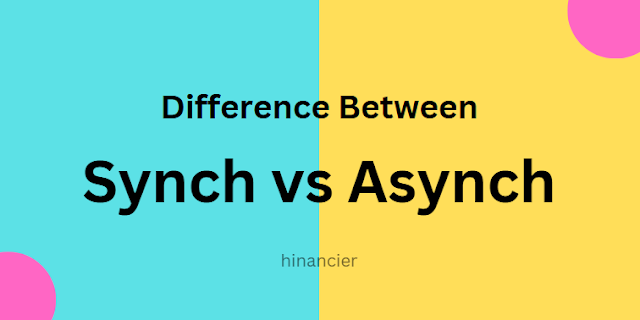 |
| synchronous vs asynchronous programming |
Synchronous and Asynchronous Programming
In Computer Science, two important programming models exist. That is - synchronous and asynchronous programming.
Although these models are quite different, they are applied in programming depending on the objective to be achieved.
A key difference between the models is the execution of tasks and handling of resources during operations.
Synchronous programming allows the handling of tasks in an orderly manner. This means that the program cannot proceed to handle one task while another task is still running.
Asynchronous programming on the other hand is different. It allows the handling of tasks in any order, even when other tasks are actively running.
Also Read:
Synchronous vs Asynchronous Programming:
What is the Difference?
 |
| synchronous vs asynchronous programming |
In synchronous programming, there is sequential execution of tasks unlike asynchronous programming where there is non-blocking execution of tasks.
Asynchronous programming model is effective when executing time-consuming tasks. It applies the use of promises, callback functions, async/await syntax to enhance an application's response time.
Synchronous Programming (Blocking /
Sequential Programming)
Synchronous programming is ideal when developing software requiring dependencies or those that have tasks to be executed sequentially.
A major set-back in this blocking-type of programming is the amount of time taken to accomplish tasks and reduced responsive time of applications.
Asynchronous / Non-blocking Programming
This programming model is effective when handling tasks that are returned concurrently. Asynchronous programming does not require the completion of another task before a second task can be accomplished.
Advantages and Disadvantages of Synchronous and
Asynchronous Programming
Depending on the need, there are several advantages and disadvantages offered by the blocking and non-blocking programming models.
Advantages of Synchronous Programming
a) Simple Code Structure - Synchronous programming is good for programming simple tasks. Therefore, its code is easier to read as it is simple and straightforward.
b) Predictable Code Execution - A task completes before another is initiated. This allows prediction in code execution making handling the control flow easy.
Disadvantages of Synchronous Programming
a) Blocking Operations - Synchronous programming halts an entire program as Input / Output (I/O) activities are aligned in a queue, each waiting for a single task to complete first. This can cause a program to be really slow.
b) Inefficient Resource Utilization - Since tasks run in a sequence, there might be the underutilization of the computer resources as the tasks are in waiting for their turn to be executed.
Advantages of Asynchronous Programming
a) Improved Performance and Responsiveness - Since multiple tasks run concurrently, there is multiple execution of tasks therefore saving time and improving responsiveness of the program.
b) Better Resource Utilization - Threads are freed up during I/O operations enabling sufficient resource utilization.
Conclusion
Both Synchronous and Asynchronous programming are important. Depending on what the developer intends to achieve, both models can be applied to accomplish the task.
However, for a more responsive application that is faster, most developers encourage the application of asynchronous programming.

إرسال تعليق